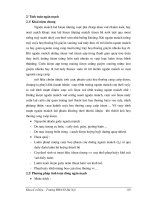THUYẾT TRÌNH CHƯƠNG 22 - PHÂN TÍCH TỔNG CUNG -TỔNG CẦU CAO HỌC TÀI CHÍNH KINH TẾ TP HCM
Bạn đang xem bản rút gọn của tài liệu. Xem và tải ngay bản đầy đủ của tài liệu tại đây (1.09 MB, 33 trang )
CHAPTER 22:
Aggregate Demand and
Supply Analysis
CONTENT
I. Aggregate Demand (AD)
• Factors That Shift the Aggregate Demand Curve
II. Aggregate Supply (AS)
• Shifts in Aggregate Supply Curves
III. Equilibrium in Aggregate Demand and Supply
Analysis
IV. Changes in Equilibrium: Aggregate Demand
Shocks
V. Changes in Equilibrium: Aggregate Supply (Price)
Shocks
I. Aggregate Demand
Aggregate demand is made up of four component
parts:
1. Consumption expenditure (C)
2. Planned investment spending (I)
3. Government purchases (G)
4. Net exports (NX)
Yad = C + I + G + NX
I. Aggregate Demand
Deriving the Aggregate Demand Curve
I. Aggregate Demand
Factors That Shift the Aggregate Demand
Curve
Seven basic factors (often referred to as demand
shocks) can shift the aggregate demand curve to a
new position:
Autonomous monetary policy:
Government purchases:
Taxes :
Autonomous net exports:
Autonomous consumption expenditure:
Autonomous investment:
Financial frictions:
II. Aggregate Supply
Long-Run Aggregate Supply Curve:
The level of aggregate output produced at the natural rate of
unemployment is called the natural rate of output but is more often referred to
as potential output: It is where the economy settles in the long run for any
inflation rate. Hence the long-run aggregate supply curve (LRAS) is vertical
at potential output, denoted by YP, as drawn in Figure 3.
Short-Run Aggregate Supply Curve :
The short-run aggregate supply curve is based on the intuition that three
factors drive inflation: (1) expectations of inflation, (2) output gap and (3)
price (supply) shocks.
II. Aggregate Supply
Shifts in Aggregate Supply Curves:
Shifts in the Long-Run Aggregate Supply Curve:
The quantity of output supplied in the long run is determined by the three
factors:
(1)
total amount
of labor
capital
in
thelabor
in
(3)(2)
thethe
available
technology
thatsupplied
puts
the
economy
economy
and capital together
to produce goods and
services
II. Aggregate Supply
Shifts in the Short-Run Aggregate Supply Curve:
Three factors can shift the short-run aggregate supply curve: (1) expected
inflation, (2) price shocks, and (3) a persistent output gap.
III. Equilibrium in Aggregate Demand and Supply
Analysis
Short-Run Equilibrium
How the Short-Run Equilibrium Moves to the Long-Run
Equilibrium over Time
Self-Correcting Mechanism
Regardless of where output is initially, it returns eventually to potential
output, a feature we call the self-correcting mechanism. The self-correcting
mechanism occurs because the short-run aggregate supply curve shifts up or
down to restore the economy to the long-run equilibrium at full employment
(aggregate output at potential) o
ver time.
IV. Changes in Equilibrium: Aggregate
Demand Shocks
The effect of a rightward shift in the aggregate demand curve
due to positive demand shocks caused by the following:
• An autonomous easing of monetary policy (r ↓, a lowering of
the real interest rate at any given inflation rate)
• An increase in government purchases (G ↑)
• A decrease in taxes (T ↓)
• An increase in net exports (NX ↑)
• An increase in autonomous consumption expenditure (C ↑)
• An increase in autonomous investment (I ↑)
• A decrease in financial frictions (f ↓)
APPLICATION:
The Volcker
Disinflation, 1980–1986
Khi Paul Volcker trở thành chủ tịch của Cục Dự trữ Liên
bang vào tháng 8 năm 1979, lạm phát đã vượt quá tầm kiểm
soát và tỷ lệ lạm phát vượt quá 10%. Volcker đã quyết tâm
giảm lạm phát. Đến đầu năm 1981, Cục Dự trữ Liên bang đã
nâng lãi suất quỹ liên bang lên hơn 20%, khiến lãi suất thực
tế tăng mạnh.
Volcker thực sự đã thành công trong việc hạ thấp lạm phát,
như bảng (b) của Hình 10 chỉ ra, với tỷ lệ lạm phát giảm từ
13,5% năm 1980 xuống 1,9% năm 1986. Sự sụt giảm lạm
phát phải trả giá đắt: Nền kinh tế trải qua giai đoạn tồi tệ
nhất suy thoái kể từ Thế chiến II, với tỷ lệ thất nghiệp trung
bình là 9,7% vào năm 1982.
.
APPLICATION:
Negative
Demand Shocks, 2001–2004
Vào năm 2000, nền kinh tế Hoa Kỳ đang mở rộng khi nó phải
chịu một loạt các cú sốc tiêu cực đối với tổng cầu.
1. "Bong bóng công nghệ" vỡ vào tháng 3 năm 2000, và thị
trường chứng khoán giảm mạnh.
2. Ngày 11 tháng 9 năm 2001, các cuộc tấn công khủng bố đã làm
suy yếu niềm tin của cả người tiêu dùng và doanh nghiệp.
3. Vụ phá sản Enron vào cuối năm 2001 và các vụ bê bối kế toán
doanh nghiệp khác vào năm 2002 tiết lộ rằng dữ liệu tài chính
doanh nghiệp không đáng tin cậy. Do đó, lãi suất trái phiếu doanh
nghiệp tăng, khiến các công ty tài trợ cho các khoản đầu tư của họ
trở nên đắt đỏ hơn
Tất cả những cú sốc về cầu tiêu cực này đã dẫn đến sự sụt
giảm chi tiêu của hộ gia đình và doanh nghiệp, làm giảm tổng cầu
.
V. Changes in Equilibrium: Aggregate
Supply (Price) Shocks
Temporary Supply Shocks:
Although a temporary negative supply shock leads to an upward and
leftward shift in the short-run aggregate supply curve, which raises
inflation and lowers output initially, the ultimate long-run effect is
that output and inflation are unchanged.
A temporary positive supply shock shifts the short-run aggregate
sup-ply curve downward and to the right, leading initially to a fall in
inflation and a rise in output. In the long run, however, output and
inflation will be unchanged (holding the aggregate demand curve
constant).
A temporary supply shock affects output and inflation only in the
short run and has no effect in the long run (holding the aggregate
demand curve constant).









